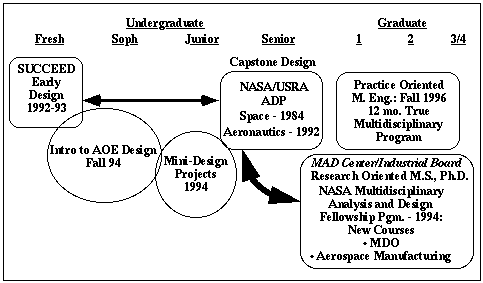
In the past several years the aircraft design program at Virginia Tech has been very active, with program advances in the standard senior level capstone course, and also at the freshman, sophomore, junior and graduate level. The objectives for strengthening the design program were severalfold. We wanted to respond to calls from the aerospace industry, primarily Boeing (McMasters and Ford, 1990) and Lockheed (Nicolai, 1992) at that time, for emphasis in engineering education beyond the normal concentration on engineering sciences. To Boeing, engineering and design are essentially the same activity. The Boeing perspective fit well with the conclusions of a study by the National Research Council (NRC, 1991), and my own observations upon moving to a university after nearly 15 years in industry. At the same time, the National Science Foundation initiated its engineering school coalition concept, and Virginia Tech joined with several other schools in the Southeast to form the SUCCEED Coalition, which was funded by the NSF in the second round of awards. At about the same time, the NASA/USRA Advanced Design Program (ADP) requested proposals for a three year program to improve design education. Virginia Tech was one of the few schools to be awarded an ADP program in both space and aeronautics.
Industry in general (Curry, 1991, and Braham, 1991), other educators (Covert, 1992, Roskam, 1992, and Goldberg, 1994), government program managers (Hazelrigg, 1994), and even Norman Augustine (Augustine, 1994a and 1994b) have begun to write about engineering education. All of this activity suggests that a shift in the approach to engineering education may be starting to occur. A survey I did a few years ago clearly showed that engineers in industry consider an understanding of how to practice engineering as least as important as specific technical discipline content (Mason, 1991).
While the activities described above focused on the undergraduate program, a strong graduate research program developing more formal approaches to design had been initiated several years earlier (Grossman, et al, 1988) in the Aerospace and Ocean Engineering Department at Virginia Tech In this research program, methods known as Multidisciplinary Design Optimization (MDO) were developed and applied to a variety of vehicle problems. This program developed until a formalization of the activities became necessary, and this was done with the establishment of the Multidisciplinary Analysis and Design (MAD) Center for Advanced Vehicles. This center collected the projects and faculty and graduate students doing multidisciplinary design research into a group that provided a coherent structure for explanation of our work to workers outside Virginia Tech. It also provided a forum to start to work closely with industry through the establishment of an industrial advisory board. Finally, the formalization of the research program required the development of a new graduate design education research program. Subsequent to the formation of the MAD Center, Virginia Tech was awarded one of the new NASA Multidisciplinary Analysis and Design Fellowship programs. Thus, the MAD Center and graduate design education program got off to a strong start. More recently we've begun to participate in a college-wide practice-oriented master's degree program. An overview of our current program is given in Fig. 1.

Figure 1. An overview of our integrated design-oriented program
Even before the design program was evolving in the Aerospace and Ocean Engineering Department, vehicle design also was receiving significant attention in the CAD Lab located in the Mechanical Engineering Department. The modernization of the NASA Ames conceptual aircraft design sizing program ACSYNT (AirCraft SYNThesis) with the addition of a powerful geometry capability for use on modern workstations (Wampler, et al, 1988) evolved into the formation of the ACSYNT Institute (Myklebust and Gelhausen, 1994). This was a collaboration between a number of government agencies, aerospace companies, and universities working together to further develop this capability, with the intent of establishing a common code for use throughout the US aircraft design community.
This remarkable confluence of activities has resulted in a highly integrated design program at Virginia Tech. This paper describes these efforts in some detail, with a discussion of the lessons learned and plans to further develop the design program based on this foundation.